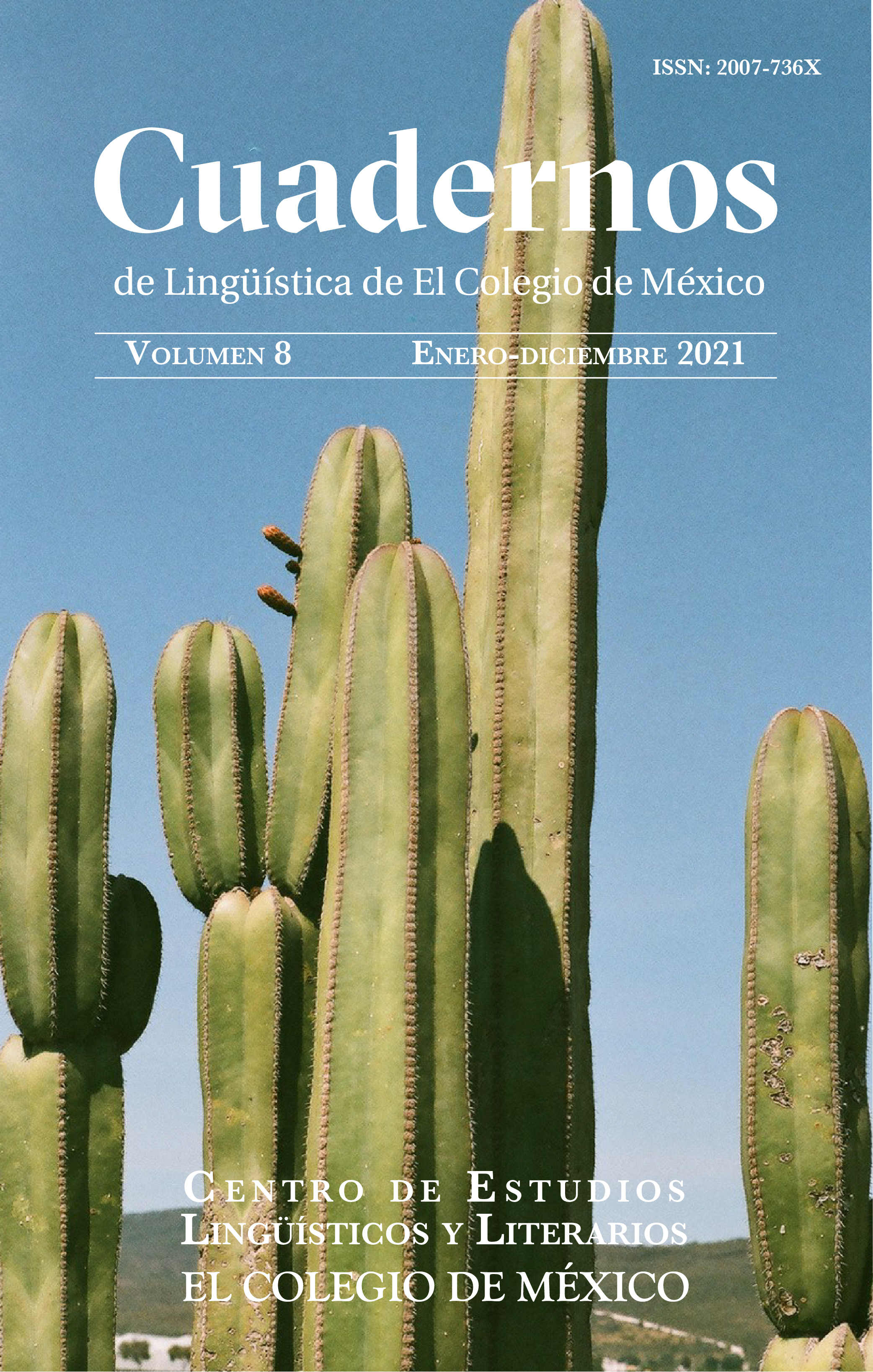Secuencias vs. unidades en las lenguas otomangues: los casos del tlapaneco (mè’phàà) y el zapoteco (dixsa:)
DOI:
https://doi.org/10.24201/clecm.v8i0.224Keywords:
segmentos complejos, tipología canónica, tlapaneco, zapotecoAbstract
Since the pioneering work of Trubetzkoy (1939), there have been various proposals as to how to distinguish consonant clusters and units in individual languages. In this paper, I will look at the cases of Malinaltepec Tlapanec (Mè’phàà) and Teotitlán del Valle Zapotec (Dixsa:), two Otomanguean languages. I will look at general and language-particular criteria to distinguish clusters and units in these languages. I will show that in both cases the criteria do not always converge: some sequences are judged to be clusters by certain criteria but as units by others. Based on these observations, and drawing insights from Canonical Typology (Brown et al. 2012), I argue that the distinction between clusters and units is not dichotomous, but multidimensional: individual cases may simultaneously resemble clusters in some aspects but units in others, thus the typology of behaviors is richer than a simple binary opposition.
Downloads
References
Anderson, Stephen. 1976. Nasality and the internal structure of segments. Language 52. 326.
Avelino, Heriberto. 1997. Fonología y morfofonología del Pame Norte. Mexico: Escuela Nacional de Antropología e Historia/Secretaria de Educación Pública. (Bachelor’s degree thesis).
Berthiaume, Scott. 2003. A Phonological grammar of Northern Pame., Texas: UT Arlington. (Doctoral dissertation).
Brown, Dunstan; Chumakina, Marina, & Corbett, Greville G. (eds.). 2012. Canonical morphology and syntax. Oxford: Oxford University Press.
Buckley, Eugene. 1992. Kashaya laryngeal increments, complex segments, and the moraic tier. Linguistic Inquiry 23. 487–496.
Buckley, Eugene. 2011. Metathesis. In van Oostendorp, M.; Ewen, Colin; Hume, E. & Rice, K. (eds.), The Blackwell Companion to Phonology. V.III. Phonological Processes. Oxford: Wiley-Blackwell. https://doi.org/10.1002/9781444335262.wbctp0059
Campbell, Eric W. 2017. Otomanguean historical linguistics: exploring the subgroups. Language & Linguistics Compass 11(7), e12244. https://doi.org/10.1111/lnc3.12244
Campbell, Lyle. 1974. Phonological features: problems and proposals. Language 50(1). 52–65.
Carrasco Zúñiga, Abad. 2006. Los procesos morfofonológicos de la lengua me'phaa, Mexico: Centro de Investigaciones y Estudios Superiores en Antropología Social. (Master´'s thesis).
Carrasco Zúñiga, Abad & Marcos Weathers D. 1988. Xó- Nitháán Me’phaa: cómo se escribe el tlapaneco. Asociación para la Promoción de Lecto-escritura Tlapaneca (APLT). Mexico, D.F.: Editorial Cuajimalpa.
Clements, George N. & Keyser, Samuel Jay. 1983. CV Phonology: a generative theory of the syllable. Cambridge, MA: MIT Press.
Corbett, Greville. 2006. Agreement. Cambridge: Cambridge University Press.
Corbett, Greville. 2015. Morphosyntactic complexity: A typology of lexical splits. Language 91(1): 145–193.
Devine, A.M. 1971. Phoneme or Cluster: a critical survey. Phonetica 24(2). 65–85.
Dingemanse, M. 2019. 'Ideophone' as a comparative concept. In Akita, K. & Pardeshi P. (eds.), Ideophones, mimetics, and expressives, 13–33. Amsterdam: John Benjamins. https://doi.org/10.1075/ill.16.02din
Gąsiorowski, Piotr. 2000. Special status: presigmatised stops. Multis vocibus de lingua, 29–38. Wydzial Neofilologii, UAM: Poznán.
Golston, Chris & Kehrein, Wolfgang. 1998. Mazatec onsets and nuclei. International Journal of American Linguistics 64(4). 311–337.
Gouskova, Maria & Stanton, Julia. 2021. Learning complex segments. Language 97(1). 151–193. 10.1353/lan.2021.0011
Hall, T. A. 2001. The distribution of superheavy syllables in modern English. Folia Linguistica: Acta Societatis Linguisticae Europaeae 35(3). 399–442. https://doi.org/10.1515/flin.2001.35.3-4.399
Hyman, Larry M. 2006. Word-prosodic typology. Phonology 23(2). 225–257. DOI: https://doi.org/10.1017/S0952675706000893
Kim, Chin-Wu. 1970. A theory of aspiration. Phonetica 21. 107–116. DOI:10.1159/000259293
Kwon, N. 2017. Total reduplication in Japanese ideophones: an exercise in localized canonical typology. Glossa: A Journal of General Linguistics 2(1) 40. 1–31. http://doi.org/10.5334/gjgl.267
Kwon, Nahyun & Round, Erich. 2015. Phonaesthemes in morphological theory. Morphology 25. 1-27.
Leben, William R. 1973. Suprasegmental phonology. Boston: MIT. (Doctoral dissertation).
Lin, Yen-Hwei. 2011. Affricates. In van Oostendorp, Marc; Ewen, Colin J.; Hume, Elizabeth & Rice, Keren (eds.). The Blackwell Companion to Phonology, 367–390. Oxford: Wiley–Blackwell.
Oropeza Bruno, Iván. 2014. Fonética, fonología y tonología del Mè’phàà de Unión de las Peras. Mexico: Escuela Nacional de Antropología e Historia. (Bachelor’s degree thesis).
Maddieson, Ian. 1984. Patterns of sounds. Cambridge: Cambridge University Press.
Marlett, Stephen. On the analysis of the glottalic element in Me’phaa. ms.
Marlett, Stephen & Weathers, Mark. 2012. Me’phaa (Tlapanec). ms.
Marlett, Stephen A. & Weathers, Mark L. 2015. La familia lingüística tlapaneca. ms.
Marlett, Stephen & Weathers; Mark. 2018. The sounds of Me’phaa (Tlapanec): a new assessment. SIL-Mexico Electronic Working Papers 25. Mexico: Instituto Lingüístico de Verano.
Martinet, A. 1939. Un ou deux phonèmes? Acta Linguistica 1(1). 94–103. https://doi.org/10.1080/03740463.1939.10410853
Navarro Solano, Abad. 2012. El patrón de alineamiento en el meʔ1phaa1. Mexico: Centro de Investigaciones y Estudios Superiores en Antropología Social. (Master’s thesis).
Nellis, Neil & Goodner de Nellis, Jane. 1983. Diccionario zapoteco de Juárez. Mexico: Instituto Lingüístico de Verano. https://www.sil.org/resources/archives/10934
Operstein, Natalie. 2012. Proto-Zapotec *tty/*ty and *ttz/*tz. International Journal of American Linguistics 78(1). 1–40. DOI: https://doi.org/10.1086/662636
Pike, Kenneth L. 1947. Phonemics: a technique for reducing languages to writing. Michigan: Ann Arbor/University of Michigan Press.
Pike, Kenneth & Pike, Eunice V. 1947. Immediate constituents of Mazateco syllables. International Journal of American Linguistics 13(2). 78–91.
Pride, Leslie & Pride, Kitty. 1970. Vocabulario chatino de Tataltepec: castellano–chatino, chatino–castellano. Mexico: SIL. https://www.sil.org/resources/archives/10951.
Rasch, Jeffrey W. 2002. The basic morpho-syntax of Yaitepec Chatino. Houston: Rice University. (Doctoral dissertation)
Round, Erich R. 2019. Canonical Phonology. (Paper presented at the Association for Linguistic Typology, Pavia, Italy, September.)
Round, Erich R. & Corbett, Greville G. 2020. Comparability and measurement in typological science: The bright future for linguistics. Linguistic Typology, 24(3). 489–525. DOI: https://doi.org/10.1515/lingty-2020-2060
Round, Erich & Macklin-Cordes, Jayden L. 2015. On the design, in practice, of typological microvariables. New Developments in the Quantitative Study of Languages. Helsinki: Linguistics association of Finland.
Ryan, Kevin. 2014. Onsets contribute to syllable weight: statistical evidence from stress and meter. Language 90(2). 309–341. doi:10.1353/lan.2014.0029
Smith-Stark, Thomas C. 2003. La ortografía del zapoteco en el Vocabulario de fray Juan de Córdova. In Romero Frizzi, María de los Ángeles (coord.), Escritura zapoteca: 2 500 años de historia, 173–239. Mexico: CIESAS/CONACULTA/INAH/Porrúa.
Stark, Donald. 1947. Mixteco: complex phonemes. Aboriginal Linguistics 1(1). 10–15.
Steriade, Donca. 1992. Segments, contours and clusters. In Crochetière, A.; Boulanger, J & Ouellon C. (eds.) Actes du XVe Congrès international des linguistes, Québec, Université Laval, 9-14 Août 1992: les langues menacées = Proceedings of the XVth International Congress of Linguists, Québec, Université Laval, 9–14 August 1992: endangered languages.
Steriade, Donca. 1994. Complex onsets as single segments: the Mazateco pattern. In Cole, J. & C. Kisseberth C. (eds.), Perspectives in Phonology, 203–291. Stanford: Center for the Study of Language and Information.
Suárez, Jorge A. 1983. La lengua tlapaneca de Malinaltepec. Mexico: Universidad Nacional Autónoma de México.
Tak, Jin-Young. 2011. Universals of prenasalized consonants: phonemic or derived, single or complex? Journal of Universal Language 12(2). 127–158.
Tiburcio Cano, Gregorio. 2017. La flexión verbal del me’phaa de Zilacayotitlán. Mexico: Centro de Investigaciones y Estudios Superiores en Antropología Social. (Master’s thesis).
Topintzi, Nina. 2006. Moraic onsets. London: University College London. (Doctoral dissertation).
Trubetzkoy, N.S. 1939[1969]. Principles of phonology (translated by Christiane A. M. Baltaxe from Trubetzkoy, N.S. 1958. Grunzüge der Phonologie. Göttingen: Vandenhoeck & Ruprecht.). University of California Press: Berkeley & Los Angeles.
Uchihara, Hiroto & Gutiérrez, Ambrocio. 2019. El texto Don Crescencio: ilustración del sistema tonal del zapoteco de Teotitlán del Valle. Tlalocan 24. 127–155. DOI: http://dx.doi.org/10.19130/iifl.tlalocan.2019.487
Uchihara, Hiroto & Gutiérrez, Ambrocio. 2020. Open and closed mid-front vowels in Teotitlán Zapotec. Phonological Data & Analysis 2(7). 1–22. DOI: 10.3765/pda.v2art7.42
Uchihara, Hiroto & Pérez Báez, Gabriela. 2016. Fortis/lenis, glides and vowels in Quiaviní Zapotec. Glossa: a journal of general linguistics 1(1). 27. 1–24. DOI: http://doi.org/10.5334/gjgl.13
Uchihara, Hiroto & Tiburcio Cano, Gregorio. In press. Foot-based allomorphy in Tlapanec (Mè’phàà). Linguistics: An Interdisciplinary Journal of the Language Sciences.
Ultan, Russell. 1978. A typological view of metathesis. In Greenberg, Joseph H.; Moravcsik, Edith; Ferguson, Charles A.; Moravcsik, Edith A. (eds.), Universals of human language: Phonology, vol. 2, 367–402. Stanford: Stanford University Press.
Weathers, Mark L. 1976. Tlapanec 1975. International Journal of American Linguistics, 42(4): 367–371.
Weathers, Esther; Weathers Mark & Marlett, Stephen. 2012. The minimal word and the syllable in Me’phaa. ms.
Weijer, Jeroen van de. 1996. Segmental structure and complex segments. Tübingen: Niemeyer.
Weijer, Jeroen van de. 2011. Secondary and double articulation. In Oostendorp, Marc van; Ewen, Colin J.; Hume, Elizabeth & Rice, Keren (eds.), The Blackwell Companion to Phonology 1, 694–710. Oxford: Wiley-Blackwell. https://doi.org/10.1002/9781444335262.wbctp0029
Downloads
Published
How to Cite
-
Abstract901
-
PDF317
-
XML5
-
EPUB69
-
Kindle156
-
MP3 (Español)23
Issue
Section
License
Copyright (c) 2021 Hiroto Huchihara

This work is licensed under a Creative Commons Attribution-NonCommercial-NoDerivatives 4.0 International License.
Authors retain copyright of their work and are free to disseminate it, make copies for any use, and/or deposit in any repository or archive of their choice, but they grant Cuadernos de Lingüística de El Colegio de México the right to publish the work for the first time. Authors agree to acknowledge Cuadernos de Lingüística de El Colegio de México as the site of original publication of their article / note / review through proper citation.
Articles appearing in Cuadernos de Lingüística de El Colegio de México are made available to readers under a Attribution-NonCommercial-NoDerivatives 4.0 International.









